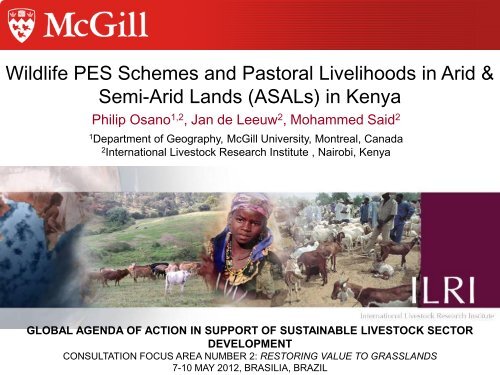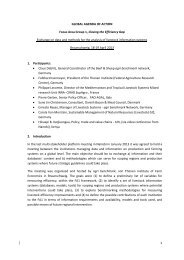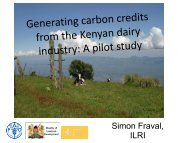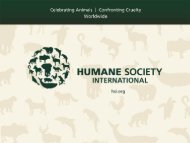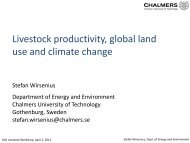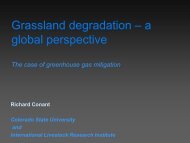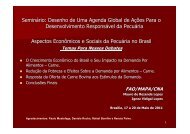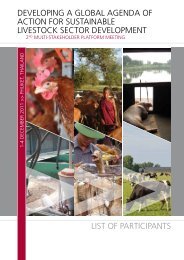Wildlife PES Schemes and Pastoral Livelihoods in Arid & Semi-Arid ...
Wildlife PES Schemes and Pastoral Livelihoods in Arid & Semi-Arid ...
Wildlife PES Schemes and Pastoral Livelihoods in Arid & Semi-Arid ...
Create successful ePaper yourself
Turn your PDF publications into a flip-book with our unique Google optimized e-Paper software.
<strong>Wildlife</strong> <strong>PES</strong> <strong>Schemes</strong> <strong>and</strong> <strong>Pastoral</strong> <strong>Livelihoods</strong> <strong>in</strong> <strong>Arid</strong> &<br />
<strong>Semi</strong>-<strong>Arid</strong> L<strong>and</strong>s (ASALs) <strong>in</strong> Kenya<br />
Philip Osano 1,2 , Jan de Leeuw 2 , Mohammed Said 2<br />
1<br />
Department of Geography, McGill University, Montreal, Canada<br />
2<br />
International Livestock Research Institute , Nairobi, Kenya<br />
GLOBAL AGENDA OF ACTION IN SUPPORT OF SUSTAINABLE LIVESTOCK SECTOR<br />
DEVELOPMENT<br />
CONSULTATION FOCUS AREA NUMBER 2: RESTORING VALUE TO GRASSLANDS<br />
7-10 MAY 2012, BRASILIA, BRAZIL
Presentation Outl<strong>in</strong>e<br />
1. Kenyan ASALS: Environmental Goods &<br />
Services<br />
2. Issues <strong>and</strong> Challenges<br />
3. Community Conservancies & <strong>Wildlife</strong> <strong>PES</strong><br />
<strong>Schemes</strong><br />
4. Ecological Outcomes<br />
5. Livelihood <strong>and</strong> Poverty Impacts<br />
6. Lessons Learnt <strong>and</strong> Future Directions
1. Kenyan ASALs: Environmental<br />
Goods & Services
1.Kenyan ASALs: Environmental Goods<br />
& Services<br />
ASAL Cover Agro-climatic Zones IV-VII<br />
100 0 100 200 Kilometers<br />
N<br />
High spatial <strong>and</strong><br />
temporal variability<br />
<strong>in</strong> precipitation <strong>and</strong><br />
temperature<br />
fluctuations<br />
NAIROBI<br />
I<br />
II<br />
III<br />
IV<br />
V<br />
VI<br />
VII<br />
Agro-climatic zones (ACZs)<br />
Mombasa<br />
Ref: Sombroek et al., 1982
1.Kenyan ASALs: Environmental Goods<br />
& Services<br />
Livestock, <strong>Wildlife</strong> <strong>and</strong> Tourism<br />
─Extensive livestock production<br />
through pastoralism<br />
─70% of national livestock<br />
population<br />
─Supply of prote<strong>in</strong> <strong>and</strong> food security<br />
─90% of wildlife <strong>and</strong> 88% of<br />
protected area <strong>in</strong> ASAL<br />
─Majority of wildlife (large mammals)<br />
live permanently or seasonally<br />
outside protected areas<br />
─<strong>Wildlife</strong> <strong>and</strong> pastoral l<strong>and</strong>scape<br />
backbone of biodiversity<br />
conservation <strong>and</strong> tourism <strong>in</strong>dustry<br />
Ref: Republic of Kenya, 2005; Norton-Griffith & Said, 2010; World Bank, 2011
2. Issues <strong>and</strong> Challenges <strong>in</strong> ASALs
2. Issues <strong>and</strong> Challenges <strong>in</strong> ASALs<br />
L<strong>and</strong> privatisation & fragmentation<br />
Policy change<br />
<strong>in</strong> property<br />
rights has led to<br />
rapid shift from<br />
large l<strong>and</strong><br />
parcels under<br />
communal<br />
tenure to small<br />
<strong>in</strong>dividuated<br />
l<strong>and</strong> parcels<br />
under private<br />
tenure<br />
Ref: Norton-Griffith, 1996; Galaty, 1994; Reid et al., Reid et al., 2004;2008
2. Issues <strong>and</strong> Challenges <strong>in</strong> ASALs<br />
Changes <strong>in</strong> human population, livestock,<br />
wildlife <strong>and</strong> cultivation <strong>in</strong> ASALs<br />
Distribution of wildlife <strong>in</strong> Kenya by l<strong>and</strong><br />
category<br />
─Decl<strong>in</strong>e <strong>in</strong> wildlife numbers <strong>and</strong> <strong>in</strong>crease livestock, human population,<br />
off-take <strong>and</strong> cultivated areas <strong>in</strong> ASALs<br />
─Overall, majority of wildlife found <strong>in</strong> private PAs; the only l<strong>and</strong> category<br />
exhibit<strong>in</strong>g positive trends <strong>in</strong> wildlife populations<br />
Ref: Norton-Griffith & Said, 2010; Western et al., 2009
2. Issues <strong>and</strong> Challenges <strong>in</strong> ASALs<br />
Agriculture expansion <strong>in</strong> ASALs (1981-2000)<br />
─Crop cultivation <strong>in</strong> ASALs<br />
<strong>in</strong>creased by 34% <strong>in</strong> 1981-<br />
2000 period<br />
─In 2000, ~ 11% of ASAL<br />
was under agriculture<br />
─Increased <strong>in</strong>tensification<br />
of livestock production <strong>in</strong><br />
ASALs<br />
Agriculture <strong>in</strong> 1981<br />
Agriculture <strong>in</strong> 2000<br />
Source & Ref: ILRI & Ref: Osano et al., 2010
2. Issues <strong>and</strong> Challenges <strong>in</strong> ASALs<br />
High rates of poverty <strong>in</strong> ASALs<br />
High poverty levels among<br />
pastoral communities also<br />
around wildlife parks <strong>and</strong><br />
reserves<br />
Conservancies<br />
Poverty rate<br />
>60<br />
50 - 60<br />
40 - 50<br />
30 - 40<br />
3. Community Conservancies & <strong>Wildlife</strong><br />
<strong>PES</strong> <strong>Schemes</strong> <strong>in</strong> ASALs
3. Community Conservancies & <strong>Wildlife</strong><br />
<strong>PES</strong> <strong>Schemes</strong> <strong>in</strong> ASALs<br />
Evolution of Community Conservancies<br />
40<br />
35<br />
100 0 100 200 Kilometers<br />
30<br />
25<br />
20<br />
15<br />
Lodwar<br />
10<br />
5<br />
N<br />
Marsabit<br />
0<br />
1991<br />
1993<br />
1995<br />
1997<br />
1999<br />
Numbers<br />
2001<br />
2003<br />
2005<br />
Cumulative<br />
2007<br />
2009<br />
Isiolo<br />
L<strong>and</strong> Tenure<br />
Fund<strong>in</strong>g<br />
Source<br />
Conservancies &<br />
<strong>PES</strong> <strong>Schemes</strong><br />
Nanyuki<br />
Garissa<br />
Narok<br />
NAIROBI<br />
Communal Tenure<br />
(Group Ranches <strong>and</strong><br />
Trust L<strong>and</strong>)<br />
2000 2010<br />
Market 2 7<br />
Public 3 14<br />
Private Tenure Market 1 9<br />
Public 1 6<br />
Total 7 36<br />
Source: ILRI (International Livestock Research Institute)<br />
Conservancies<br />
Established<br />
No data<br />
2000s<br />
1990s<br />
I (humid)<br />
II (sub-humid)<br />
III (semi-humid)<br />
IV (semi-humid to semi-arid)<br />
V (semi-arid)<br />
VI (arid)<br />
VII (very arid)<br />
Mombasa
3. Community Conservancies & <strong>Wildlife</strong><br />
<strong>PES</strong> <strong>Schemes</strong> <strong>in</strong> ASALs<br />
<strong>PES</strong> Case 1: <strong>Wildlife</strong> Lease Program<br />
Secure the wildlife dispersal<br />
area <strong>and</strong> migratory corridor<br />
for Nairobi National Park by<br />
pay<strong>in</strong>g pastoralists<br />
US$10/ha/yr<br />
Conditionalities <strong>in</strong> WLP<br />
─No sell<strong>in</strong>g of l<strong>and</strong> enrolled <strong>in</strong><br />
<strong>PES</strong> scheme<br />
─No-sub divid<strong>in</strong>g l<strong>and</strong> <strong>in</strong> lease<br />
─No fenc<strong>in</strong>g of l<strong>and</strong> <strong>in</strong> lease<br />
─L<strong>and</strong>owners to refra<strong>in</strong> from<br />
<strong>and</strong> report poach<strong>in</strong>g<br />
─Protect natural vegetation
3. Community Conservancies & <strong>Wildlife</strong><br />
<strong>PES</strong> <strong>Schemes</strong> <strong>in</strong> ASALs<br />
Enrolment & Payments <strong>in</strong> the WLP<br />
Trend <strong>in</strong> enrollment <strong>in</strong> <strong>Wildlife</strong><br />
Lease Scheme (2000-2010)<br />
Total <strong>PES</strong> payments to WLP<br />
Households (<strong>in</strong> 2005'$)<br />
2010<br />
357<br />
2010<br />
200.14<br />
2009<br />
240<br />
2009<br />
109.43<br />
2008<br />
148<br />
2008<br />
57.81<br />
2007<br />
111<br />
2007<br />
41.01<br />
2006<br />
115<br />
2006<br />
13.47<br />
2005<br />
115<br />
2005<br />
38.77<br />
2004<br />
114<br />
2004<br />
39.11<br />
2003<br />
117<br />
2003<br />
43.04<br />
2002<br />
99<br />
2002<br />
36.98<br />
2001<br />
66<br />
2001<br />
19.35<br />
2000<br />
18<br />
2000<br />
6.05<br />
0 50 100 150 200 250 300 350 400<br />
No. of enrolled households<br />
0 50 100 150 200 250<br />
Amount paid (US$, 000's)<br />
Ref: Osano et al., (forthcom<strong>in</strong>g)
3. Community Conservancies & <strong>Wildlife</strong><br />
<strong>PES</strong> <strong>Schemes</strong> <strong>in</strong> ASALs<br />
<strong>PES</strong> Case 2: Olare Orok Conservancy (OOC)<br />
<strong>Pastoral</strong> l<strong>and</strong> owners paid<br />
btwn US$ 30-40/ha/yr to<br />
consolidate <strong>and</strong> lease<br />
<strong>in</strong>dividual l<strong>and</strong> parcels to<br />
private <strong>in</strong>vestors for high end<br />
wildlife tourism <strong>and</strong><br />
conservation <strong>in</strong> the<br />
dispersal area of Maasai<br />
Mara National Reserve<br />
Conditionalities <strong>in</strong> OOC<br />
─Exclusion of settlements <strong>in</strong><br />
the conservancy<br />
─Restriction on cattle graz<strong>in</strong>g<br />
except <strong>in</strong> drought periods<br />
(controlled)<br />
─Restrictions on l<strong>and</strong> sales
3. Community Conservancies & <strong>Wildlife</strong><br />
<strong>PES</strong> <strong>Schemes</strong> <strong>in</strong> ASALs<br />
Replication of OOC <strong>PES</strong> Model (2006)<br />
Masai Mara<br />
Game Reserve<br />
5 0 5 10 15 20 25 30 35 Kilometers<br />
Conservancy & Area (Ha)<br />
1. Olare Orok (9,720)<br />
2. Olk<strong>in</strong>yei (4,856)<br />
Maasai Mara<br />
National Reserve<br />
N<br />
50 0 50 100 Kilometers
3. Community Conservancies & <strong>Wildlife</strong><br />
<strong>PES</strong> <strong>Schemes</strong> <strong>in</strong> ASALs<br />
Replication of OOC <strong>PES</strong> Model (2006-2012)<br />
• Total area under<br />
conservancy quickly<br />
exp<strong>and</strong>ed<br />
Masai Mara<br />
Game Reserve<br />
5 0 5 10 15 20 25 30 35 Kilometers<br />
Conservancy & Area (Ha)<br />
1. Olare Orok (9,720)<br />
2. Olk<strong>in</strong>yei (4,856)<br />
3. Motorogi (5,466)<br />
4. Mara North (30,955)<br />
5. Naboisho (20,946)<br />
6. Enoonkishu (6,566)<br />
7. Lemek (6,860)<br />
8. Ol-Chorro (6,879)<br />
Maasai Mara<br />
National Reserve<br />
N<br />
50 0 50 100 Kilometers
3. Community Conservancies & <strong>Wildlife</strong><br />
<strong>PES</strong> <strong>Schemes</strong> <strong>in</strong> ASALs<br />
Comparison between <strong>PES</strong> Case 1 & 2<br />
Case 1: <strong>Wildlife</strong><br />
Lease Program<br />
Case 2: Olare Orok<br />
Conservancy (OOC)<br />
Year started/period 2000 (12 years) 2006 (5 years)<br />
No. of l<strong>and</strong>holders 357 (2010) 157 (2010)<br />
L<strong>and</strong> Tenure Private, <strong>in</strong>dividuated Private , <strong>in</strong>dividuated<br />
Area of l<strong>and</strong> 16,700ha (2010) 10,000ha<br />
Fund<strong>in</strong>g source<br />
Contract arrangement<br />
(period)<br />
Governance<br />
Public fund<strong>in</strong>g<br />
(Government <strong>and</strong><br />
World Bank/GEF)<br />
Individual contract<br />
(1 year)<br />
Intermediary: NGO<br />
(The <strong>Wildlife</strong><br />
Foundation)<br />
Market fund<strong>in</strong>g<br />
(Private tourism enterprises<br />
<strong>and</strong> <strong>in</strong>vestors)<br />
Group contract<br />
(5 & 10 years)<br />
Intermediary:<br />
Private company<br />
(Ol Purkel Ltd)
4. Ecological Outcomes of <strong>Wildlife</strong> <strong>PES</strong><br />
<strong>Schemes</strong>
4. Ecological Outcomes of <strong>Wildlife</strong> <strong>PES</strong><br />
<strong>Schemes</strong><br />
<strong>PES</strong> & wildlife dispersal/migration corridor <strong>in</strong><br />
ASALs <strong>in</strong> Southern Kenya<br />
Mara<br />
Athi Kaputie<br />
Source: DRSRS (Department of Resource Surveys & Remote Sens<strong>in</strong>g) et al. (<strong>in</strong> prep)
4. Ecological Outcomes of <strong>Wildlife</strong> <strong>PES</strong><br />
<strong>Schemes</strong><br />
# #<br />
N<br />
N<br />
N<br />
N<br />
Distribution of selected species <strong>in</strong> Athi Kaputie<br />
Pla<strong>in</strong>s<br />
Nairobi City<br />
Location Map<br />
Nairobi City<br />
Location Map<br />
Ngong<br />
#<br />
Kiserian #<br />
# # #<br />
#<br />
#<br />
Nairobi National<br />
Park<br />
Rongai<br />
#<br />
# # #<br />
#### ## ##<br />
# # ### # #<br />
# # # #<br />
##<br />
# # # # # # # # # #<br />
# ##<br />
#<br />
### #<br />
#<br />
#<br />
# # ##<br />
#<br />
# #<br />
##<br />
# # ## # # # ## # ##### ###<br />
#<br />
# #<br />
# ###<br />
# ## #<br />
# #<br />
#<br />
##<br />
# ## # # #<br />
# #<br />
#<br />
#<br />
##<br />
#<br />
#<br />
#<br />
#<br />
### # #<br />
#<br />
#<br />
# # ##<br />
##<br />
# # ## # #<br />
#<br />
#<br />
# #<br />
##<br />
# # ##<br />
#<br />
### # #<br />
# #<br />
#<br />
#<br />
# # #<br />
# # ##<br />
# #<br />
# ## #<br />
##<br />
#<br />
# # Athi River<br />
# ##<br />
#<br />
#<br />
####<br />
#<br />
#<br />
# #<br />
#<br />
# # #<br />
# ##<br />
# ##<br />
##<br />
##<br />
# #<br />
# # # ##<br />
#<br />
#<br />
#<br />
### ####<br />
#<br />
# #<br />
# ## #<br />
Kitengela<br />
# #<br />
#<br />
## # #<br />
####<br />
#<br />
#<br />
### #<br />
# #<br />
# #<br />
# #<br />
# # #<br />
# #<br />
##<br />
#<br />
##<br />
##<br />
#<br />
#<br />
# #<br />
# #<br />
#<br />
#<br />
## #<br />
# #<br />
# #<br />
#<br />
# ##<br />
# # #<br />
# ## #<br />
#<br />
#<br />
# # # #<br />
## #<br />
#<br />
# #<br />
#<br />
#<br />
#<br />
# #<br />
#<br />
#<br />
# # # # # #<br />
#<br />
# #<br />
##<br />
#<br />
# #<br />
# #<br />
# # ##<br />
#<br />
#<br />
#<br />
# ## # #<br />
# # #<br />
#<br />
# #<br />
##<br />
#<br />
# ## #<br />
# #<br />
# ##<br />
# #<br />
#<br />
#<br />
#<br />
#<br />
#<br />
# ## #<br />
#<br />
# #<br />
# ##<br />
# Olooloitikoshi<br />
#<br />
# #<br />
#<br />
# # # # # # ## #<br />
# ##<br />
# # # # # #<br />
# # #<br />
# #<br />
## # # # # #<br />
## # ### # #<br />
# # # ### # # #<br />
#<br />
### # #<br />
# # #<br />
#<br />
### # ###<br />
# # # ## # #<br />
##<br />
#<br />
# # ##<br />
## # ## ## # #<br />
#<br />
### #<br />
# ## ## # # # # # #<br />
#<br />
# ## #<br />
## #<br />
# # #<br />
#<br />
##<br />
## #<br />
# # # # # # ## #<br />
# # ##<br />
## #<br />
# # # #<br />
# #<br />
#<br />
# #<br />
#<br />
#<br />
# # #<br />
#<br />
# #<br />
#<br />
#<br />
#<br />
#<br />
#<br />
#<br />
#<br />
##<br />
#<br />
# # #<br />
#<br />
##<br />
# #<br />
# # # ##<br />
###<br />
# # ## #<br />
# # #<br />
# # # ##<br />
##<br />
# # ##<br />
### ##<br />
## #<br />
#<br />
###<br />
#<br />
#<br />
## # ### ## # # # # ## #<br />
#<br />
#<br />
# ##<br />
#<br />
# #<br />
# ###<br />
# # #<br />
#<br />
###<br />
#<br />
# #<br />
## # ## #<br />
# ##<br />
# #<br />
## #<br />
###<br />
#<br />
### # # ##<br />
##<br />
###<br />
# #<br />
# #<br />
## ### ## Is<strong>in</strong>ya<br />
#####<br />
#<br />
#<br />
##<br />
#<br />
# #<br />
##<br />
#<br />
## # # # # ###<br />
# #<br />
##<br />
## ##<br />
###<br />
#<br />
# # #<br />
# ###<br />
## # #<br />
## # # # # # #<br />
#<br />
#<br />
##<br />
# #<br />
#<br />
#<br />
#<br />
# # ###<br />
#<br />
# # #<br />
#<br />
# # #<br />
## #<br />
# # # #<br />
#<br />
# #<br />
# # ## # # #<br />
# #<br />
#<br />
#<br />
# #<br />
# ## # # # # #<br />
#<br />
# # #<br />
# # # #<br />
#<br />
##<br />
#<br />
##<br />
# # ### # # ####<br />
#<br />
# ## # # # #<br />
# # # # #<br />
#<br />
# # # # #<br />
# #<br />
#<br />
# #<br />
# # #### # # # # # #<br />
##<br />
## ## #<br />
####<br />
# # # #<br />
####<br />
# # ## # ## ###<br />
##<br />
#<br />
#<br />
# #<br />
#<br />
# # ###<br />
#<br />
##<br />
# # #<br />
# # #<br />
# # #<br />
#<br />
#<br />
##<br />
# # ## # # #<br />
### # #<br />
##<br />
#<br />
##<br />
Kajiado #<br />
# ##<br />
# # #<br />
#<br />
# #<br />
# ##<br />
#<br />
# #<br />
#<br />
##<br />
##<br />
##<br />
# #<br />
# ###<br />
#<br />
Lukenya<br />
#<br />
#<br />
#<br />
#<br />
#<br />
##<br />
# # #<br />
#<br />
# #<br />
Konza<br />
#<br />
Kenya<br />
Nairobi District<br />
Kajiado District<br />
INDIAN<br />
Tanzania<br />
OCEAN<br />
Legend<br />
# Cattle O bserv ed<br />
# Towns<br />
Major Rivers<br />
Fences<br />
Nairobi National P ark<br />
N<br />
0 20 Kilo me te rs<br />
Ngong<br />
#<br />
Kiserian #<br />
Rongai<br />
#<br />
#<br />
# # # # ## #<br />
#<br />
##<br />
## # ##<br />
#<br />
# ##<br />
# #<br />
#<br />
#<br />
Olooloitikoshi #<br />
#<br />
#<br />
#<br />
Kajiado #<br />
Nairobi National<br />
Park<br />
#<br />
#<br />
# ##<br />
# #<br />
#<br />
#<br />
#<br />
# #<br />
##<br />
##<br />
# #<br />
#<br />
##<br />
## # #<br />
#<br />
#<br />
Is<strong>in</strong>ya<br />
#<br />
#<br />
## #<br />
#<br />
#<br />
#<br />
#<br />
# #<br />
#<br />
#<br />
#<br />
# #<br />
# #<br />
##<br />
#<br />
#<br />
#<br />
#<br />
#<br />
#<br />
# ## #<br />
#<br />
#<br />
#<br />
#<br />
#<br />
#<br />
# #<br />
##<br />
#<br />
##<br />
## #<br />
##<br />
#<br />
#<br />
#<br />
# #<br />
# #<br />
# # #<br />
## ##<br />
# ##<br />
#<br />
#<br />
#<br />
#<br />
# #<br />
#<br />
#<br />
#<br />
#<br />
#<br />
#<br />
#<br />
#<br />
##<br />
##<br />
#<br />
# #<br />
#<br />
#<br />
#<br />
#<br />
#<br />
#<br />
#<br />
#<br />
#<br />
#<br />
#<br />
#<br />
#<br />
#<br />
# Kitengela<br />
#<br />
Athi River<br />
#<br />
#<br />
#<br />
# # # #<br />
#<br />
#<br />
#<br />
#<br />
#<br />
# # #<br />
# #<br />
####<br />
#<br />
#<br />
#<br />
#<br />
Lukenya<br />
#<br />
#<br />
#<br />
#<br />
#<br />
#<br />
Konza<br />
#<br />
Kenya<br />
Nairobi District<br />
Kajiado District<br />
INDIAN<br />
Tanzania<br />
OCEAN<br />
Legend<br />
# Zebra O bserv ed<br />
# Towns<br />
Major Rivers<br />
Fences<br />
Nairobi National P ark<br />
N<br />
0 20 Kilo me te rs<br />
Nairobi City<br />
Location Map<br />
Nairobi City<br />
Location Map<br />
Ngong<br />
#<br />
Kiserian #<br />
Rongai<br />
## #<br />
# # #<br />
# #<br />
#<br />
#<br />
#<br />
##<br />
#<br />
#<br />
#<br />
# ##<br />
#<br />
##<br />
#<br />
##<br />
# # #<br />
#<br />
#<br />
# ## ## # #<br />
#<br />
#<br />
### # #<br />
# ##<br />
#<br />
#<br />
## ## # # # ## # # #<br />
##<br />
#<br />
# #<br />
# #<br />
##<br />
Athi River<br />
## #<br />
# # # # # #<br />
#<br />
#<br />
#<br />
# #<br />
# Kitengela<br />
#<br />
#<br />
#<br />
##<br />
#<br />
#<br />
#<br />
##<br />
#<br />
#<br />
##<br />
#<br />
# # ##<br />
#<br />
## ###<br />
# ## #<br />
# #<br />
#<br />
# # #<br />
#<br />
# #<br />
##<br />
## #<br />
# # #<br />
#<br />
# # #<br />
#<br />
### #<br />
# # ##<br />
#<br />
# # # ##<br />
#<br />
# # #<br />
#<br />
#<br />
#<br />
# ## # #<br />
##<br />
#<br />
# # # #<br />
#<br />
# #<br />
# #<br />
# #<br />
##### # ##<br />
## #<br />
#<br />
##<br />
## #<br />
# # ## #<br />
## ##<br />
#<br />
#<br />
#<br />
## # # #<br />
# # # ###<br />
# #<br />
#<br />
# # # #<br />
#<br />
#<br />
##<br />
#<br />
# ##<br />
## #<br />
#<br />
# #<br />
#<br />
# ##<br />
#<br />
#<br />
# ###<br />
# # # #<br />
## #<br />
### # # ## # #<br />
#<br />
# ##<br />
# # #<br />
# ## ## #<br />
#<br />
#<br />
#<br />
# #<br />
## #<br />
##<br />
#<br />
#<br />
#<br />
# #<br />
#<br />
##<br />
#<br />
#<br />
# # ##<br />
# # #<br />
##<br />
Is<strong>in</strong>ya #<br />
#<br />
#<br />
#<br />
## ##<br />
# # ##<br />
###<br />
#<br />
#<br />
#<br />
# # #<br />
# # ### #<br />
# ###<br />
# #<br />
#<br />
#<br />
#<br />
#<br />
# # # #<br />
# #<br />
# # #<br />
## #<br />
# #<br />
#<br />
## #<br />
# #<br />
## # # #<br />
# #<br />
# #<br />
#<br />
##<br />
#<br />
# # #<br />
# #<br />
#<br />
#<br />
# # # # ### #<br />
##<br />
# #<br />
##<br />
# #<br />
#<br />
#<br />
#<br />
#<br />
#<br />
# ## # #<br />
#<br />
# # # #<br />
#<br />
#<br />
## # # # ##<br />
##<br />
#<br />
#<br />
# # # ## # # #<br />
#<br />
#<br />
# # # #<br />
#<br />
# ### #<br />
# # #<br />
# # # ## # #<br />
## #<br />
#<br />
# # #<br />
#<br />
#<br />
# #<br />
Olooloitikoshi<br />
Nairobi National<br />
Park<br />
Lukenya<br />
##<br />
#<br />
Konza<br />
#<br />
Kenya<br />
Nairobi District<br />
Kajiado District<br />
INDIAN<br />
Tanzania<br />
OCEAN<br />
Legend<br />
# Thomson's gazelle O bs erved<br />
# Towns<br />
Major Rivers<br />
Fences<br />
Nairobi National P ark<br />
N<br />
0 20 Kilo me te rs<br />
Ngong<br />
#<br />
Kiserian #<br />
Rongai<br />
#<br />
#<br />
# #<br />
#<br />
Olooloitikoshi<br />
Nairobi National<br />
Park<br />
#<br />
#<br />
#<br />
#<br />
#<br />
# # ##<br />
Is<strong>in</strong>ya<br />
#<br />
#<br />
# # # #<br />
#<br />
#<br />
#<br />
#<br />
# # # #<br />
#<br />
#<br />
#<br />
#<br />
#<br />
#<br />
#<br />
#<br />
#<br />
#<br />
#<br />
#<br />
#<br />
# #<br />
#<br />
# # #<br />
#<br />
#<br />
#<br />
#<br />
##<br />
#<br />
#<br />
## ##<br />
# #<br />
#<br />
#<br />
####<br />
#<br />
# #<br />
#<br />
### #<br />
###<br />
# # #<br />
#<br />
# #<br />
#<br />
## #<br />
##<br />
#<br />
### #<br />
# #<br />
# # #<br />
#<br />
# # #<br />
# #<br />
# #<br />
##<br />
#<br />
##<br />
# #<br />
# # # #<br />
##<br />
# #<br />
#<br />
# # #<br />
# #<br />
#<br />
# #<br />
#<br />
#<br />
#<br />
#<br />
#<br />
#<br />
#<br />
#<br />
#<br />
#<br />
#<br />
#<br />
#<br />
#<br />
#<br />
#<br />
#<br />
#<br />
#<br />
#<br />
#<br />
#<br />
# # #<br />
# #<br />
#<br />
Athi River<br />
# Kitengela<br />
# #<br />
#<br />
#<br />
# ##<br />
#<br />
#<br />
## #<br />
# #<br />
# #<br />
#<br />
#<br />
#<br />
#<br />
#<br />
#<br />
#<br />
#<br />
# # #<br />
#<br />
Lukenya<br />
#<br />
Konza<br />
#<br />
Kenya<br />
Nairobi District<br />
Kajiado District<br />
INDIAN<br />
Tanzania<br />
OCEAN<br />
Legend<br />
# W ildebeest O bserved<br />
# Towns<br />
Major Rivers<br />
Fences<br />
Nairobi National P ark<br />
N<br />
0 20 Kilo me te rs<br />
Kajiado<br />
#<br />
#<br />
Kajiado<br />
#
4. Ecological Outcomes of <strong>Wildlife</strong> <strong>PES</strong><br />
<strong>Schemes</strong><br />
Ref: Osano et al., forthcom<strong>in</strong>g<br />
<strong>PES</strong> & wildlife dispersal/migration corridor <strong>in</strong><br />
Athi Kaputie Pla<strong>in</strong>s
4. Ecological Outcomes of <strong>Wildlife</strong> <strong>PES</strong><br />
<strong>Schemes</strong><br />
Ref: Osano et al., forthcom<strong>in</strong>g<br />
Impact on fenc<strong>in</strong>g <strong>and</strong> blockade of wildlife &<br />
livestock mobility <strong>in</strong> Athi Kaputie Pla<strong>in</strong>s
4. Ecological Outcomes of <strong>Wildlife</strong> <strong>PES</strong><br />
<strong>Schemes</strong><br />
Ref: Ogutu et al., 2011<br />
Potential Leakages <strong>and</strong> Knock-off effects on<br />
Park <strong>and</strong> Communal L<strong>and</strong>s
5. <strong>Pastoral</strong> Livelihood <strong>and</strong> Poverty<br />
Impacts
5. <strong>Pastoral</strong> Livelihood <strong>and</strong> Poverty<br />
Impacts of <strong>Wildlife</strong> <strong>PES</strong> <strong>Schemes</strong><br />
‘Safety-net’: Contribution of <strong>PES</strong> to Household<br />
Income <strong>in</strong> the WLP & OOC <strong>in</strong> 2008-2009<br />
NDVI<br />
Photo credit: Brendan Cox/Flick<br />
─<strong>PES</strong> <strong>in</strong>come represents<br />
an <strong>in</strong>valuable source of<br />
<strong>in</strong>come diversification <strong>in</strong><br />
periods of severe drought<br />
e.g. 2008-2009<br />
─<strong>PES</strong> can provide a<br />
‘safety net’ for pastoral<br />
households <strong>in</strong> deal<strong>in</strong>g<br />
with environmental<br />
shocks<br />
Ref: Osano, 2011; Zwaagstra et al., 2011
5. <strong>Pastoral</strong> Livelihood <strong>and</strong> Poverty<br />
Impacts of <strong>Wildlife</strong> <strong>PES</strong> <strong>Schemes</strong><br />
Determ<strong>in</strong>ants of Participation <strong>and</strong> Poverty <strong>in</strong> the<br />
WLP <strong>PES</strong> Scheme<br />
Explanatory Variable Co-efficient z-value P>IzI<br />
Size of Farm (ha) 0.005 2.51 0.012<br />
<strong>Wildlife</strong> predation 0.864 2.05 0.041<br />
Adult labour 0.163 2.04 0.042<br />
NDVI_lag3 (2004-2009) -9.769 -2.33 0.020<br />
Composite Asset Index (CAI) 0.622 1.82 0.069<br />
Constant -0.747<br />
Pseudo R2 0.172<br />
N 158<br />
─Richer households with greater asset endowments, <strong>in</strong>clud<strong>in</strong>g<br />
larger farms, <strong>and</strong> occupy<strong>in</strong>g areas with higher graz<strong>in</strong>g<br />
potential are the most likely to participate <strong>in</strong> the WLP<br />
Ref: Osano et al., forthcom<strong>in</strong>g
5. <strong>Pastoral</strong> Livelihood <strong>and</strong> Poverty<br />
Impacts of <strong>Wildlife</strong> <strong>PES</strong> <strong>Schemes</strong><br />
Per capita poverty impact of <strong>PES</strong> <strong>in</strong> OOC<br />
N<br />
Mean <strong>in</strong>come<br />
(US$/person/day)<br />
CV<br />
% Contribution to<br />
household <strong>in</strong>come<br />
Agriculture <strong>Wildlife</strong><br />
Conservation<br />
Mara Group 210 0.84 116 70 21<br />
Ranches (1998-2004)<br />
OOC – <strong>PES</strong> 2009 58 1.51 157 79<br />
OOC + <strong>PES</strong> 2009 73 2.45 93 42 40<br />
Individuals: Higher <strong>in</strong>come for those benefitt<strong>in</strong>g from <strong>PES</strong> <strong>in</strong><br />
Olare Orok Conservancy (OOC)<br />
Households: Significant (40%) household <strong>in</strong>come derived<br />
from <strong>PES</strong> payments <strong>in</strong> 2009<br />
Equity <strong>in</strong>come among households <strong>in</strong>creased because families<br />
received more or less same area of l<strong>and</strong><br />
Ref: Osano et al., (<strong>in</strong> prep.)
6. Lessons Learnt <strong>and</strong> Future<br />
Directions
5. Lessons Learnt <strong>and</strong> Future<br />
Directions<br />
Lesson 1: L<strong>and</strong> tenure system can be a<br />
constra<strong>in</strong>t or enabl<strong>in</strong>g factor <strong>in</strong> <strong>PES</strong><br />
─Privatisation of pastoral l<strong>and</strong>s <strong>in</strong> ASALs led to expansion of<br />
l<strong>and</strong>uses that are <strong>in</strong>compatible with pastoralism (extensive<br />
livestock production) <strong>and</strong> wildlife conservation; cropp<strong>in</strong>g,<br />
fenc<strong>in</strong>g etc;<br />
─Privatisation of pastoral l<strong>and</strong>s <strong>in</strong> ASALs provided <strong>in</strong>dividual<br />
l<strong>and</strong>owners security of tenure hitherto not guaranteed <strong>in</strong><br />
communal l<strong>and</strong> tenure system, <strong>and</strong> enabled l<strong>and</strong>owners to<br />
capture benefits of <strong>PES</strong> payments at the household level<br />
─Self organised private <strong>PES</strong> schemes tapp<strong>in</strong>g <strong>in</strong>to market<br />
fund<strong>in</strong>g are more common under private, <strong>in</strong>dividuated l<strong>and</strong><br />
tenure regimes while public funded <strong>PES</strong> schemes tapp<strong>in</strong>g <strong>in</strong>to<br />
government <strong>and</strong> NGOs fund<strong>in</strong>g are more common under public<br />
<strong>and</strong> communal (private) l<strong>and</strong> tenure regimes
5. Lessons Learnt <strong>and</strong> Future<br />
Directions<br />
Lesson 2: <strong>PES</strong> <strong>in</strong>volves synergies <strong>and</strong> trade-offs<br />
among pastoralism, <strong>in</strong>come <strong>and</strong> wildlife<br />
conservation<br />
─Higher payments to pastoral l<strong>and</strong>owners are necessary for<br />
<strong>PES</strong> with conditionalities that do not support pastoral livelihoods<br />
(e.g. US$ 43/ha/year <strong>in</strong> OOC for restriction to settlements <strong>and</strong><br />
livestock graz<strong>in</strong>g) compared to <strong>PES</strong> conditionalities that support<br />
traditional pastoral livelihoods (e.g. US$ 10/ha/year <strong>in</strong> the WLP)<br />
─<strong>PES</strong> is a critical source of <strong>in</strong>come diversification for pastoral<br />
households, dur<strong>in</strong>g periods of shock such as drought when <strong>PES</strong><br />
<strong>in</strong>come can buffer households from fluctuat<strong>in</strong>g livestock <strong>in</strong>come<br />
─<strong>Wildlife</strong> <strong>PES</strong> schemes tapp<strong>in</strong>g <strong>in</strong>to funds from the tourist<br />
sector may promote the conservation of only species of tourist<br />
value such as charismatic carnivores overlook<strong>in</strong>g knock-off<br />
effect on the larger ecosystem such as displacement of graz<strong>in</strong>g<br />
pressure
5. Lessons Learnt <strong>and</strong> Future<br />
Directions<br />
Lesson 3: Pay attention to poverty <strong>and</strong> equity<br />
implications<br />
─L<strong>and</strong> based <strong>PES</strong> schemes among pastoral households<br />
exclude the l<strong>and</strong>less poor <strong>and</strong> women from direct benefits<br />
─High <strong>in</strong>equality exists <strong>in</strong> terms of cash <strong>in</strong>come, livestock<br />
assets, l<strong>and</strong> hold<strong>in</strong>gs <strong>and</strong> other assets among potential<br />
enviromental service providers, which is likely to favor non-poor<br />
households <strong>in</strong> terms of <strong>PES</strong> participation<br />
─Over 40 community based conservancies <strong>in</strong> Kenya (1 million<br />
ha); Payments from $1 to $40/ha – sufficient to impact poverty<br />
levels<br />
─Review of different sources of <strong>in</strong>come shows that <strong>in</strong> both OOC<br />
<strong>and</strong> WLP <strong>PES</strong> <strong>Schemes</strong>, <strong>PES</strong> payments is the most equitable of<br />
all the <strong>in</strong>come sources irrespective of exist<strong>in</strong>g <strong>in</strong>equalities <strong>in</strong> l<strong>and</strong><br />
ownership (high <strong>in</strong>equality for WLP <strong>and</strong> low <strong>in</strong>equality for OOC)
5. Lessons Learnt <strong>and</strong> Future<br />
Directions<br />
Lesson 4: Plan for “Climate-smart” <strong>PES</strong><br />
─Evidence shows that drought effects <strong>and</strong> grassl<strong>and</strong> vegetation<br />
conditions is a significant determ<strong>in</strong>ant of participation of pastoral<br />
households <strong>in</strong> wildlife <strong>PES</strong> schemes<br />
─In the short-term, variability <strong>in</strong> climate will impact<br />
conservancies <strong>and</strong> <strong>PES</strong> schemes differently<br />
Precipitation change (1970-2025)<br />
Temperature change (1970-2025)<br />
Lodwar<br />
#<br />
Lodwar<br />
#<br />
#<br />
Marsabit<br />
#<br />
Marsabit<br />
N<br />
Isiolo<br />
#<br />
#<br />
Nanyuki<br />
#<br />
Garissa<br />
#<br />
Narok<br />
#<br />
#<br />
Isiolo<br />
#<br />
Nanyuki<br />
NAIROBI<br />
#<br />
Garissa<br />
Precipitation change<br />
< -150mm<br />
< -100mm<br />
< -50mm<br />
+ or -50mm<br />
< +50mm<br />
#<br />
Narok<br />
Conservancies<br />
NAIROBI<br />
#<br />
Mombasa<br />
#<br />
Conservancies<br />
Temperature change<br />
5. Lessons Learnt <strong>and</strong> Future<br />
Directions<br />
Lesson 5: Multiple policy goals<br />
(Kenya Vision 2030)
5. Lessons Learnt <strong>and</strong> Future<br />
Directions<br />
Lesson 5: Multiple policy goals <strong>and</strong> strategies<br />
1. National ASAL Vision <strong>and</strong> Strategy<br />
2. National Climate Change Response Strategy<br />
3. Sectoral Strategies (Tourism, <strong>Wildlife</strong>, Livestock, L<strong>and</strong><br />
etc)
5. Lessons Learnt <strong>and</strong> Future<br />
Directions<br />
References<br />
FEWSNET (2010). La N<strong>in</strong>a <strong>and</strong> Food Security <strong>in</strong> East Africa. Wash<strong>in</strong>gton, D.C.: FEWSNET (Fam<strong>in</strong>e Early Warn<strong>in</strong>g System <strong>in</strong> East Africa) <strong>and</strong> USAID.<br />
Galaty, J. G. (1994). Ha(l)v<strong>in</strong>g l<strong>and</strong> <strong>in</strong> common: the subdivision of Maasai group ranches <strong>in</strong> Kenya. Nomadic Peoples, 34/35, 109-122.<br />
Homewood, K., Kristjanson, P., & Trench, P., C. (Eds.). (2009). Stay<strong>in</strong>g Maasai <strong>Livelihoods</strong>, Conservation <strong>and</strong> Development <strong>in</strong> East Africa's<br />
Rangel<strong>and</strong>s: Spr<strong>in</strong>ger.<br />
Little, P. D., McPeak, J., Barrett, C. B., & Kristjanson, P. (2008). Challeng<strong>in</strong>g Orthodoxies: Underst<strong>and</strong><strong>in</strong>g Poverty <strong>in</strong> <strong>Pastoral</strong> Areas of East Africa.<br />
Development <strong>and</strong> Change, 39(4), 587-611.<br />
National Environment Management Authority (2011). KENYA: State of the Environment And Outlook 2010. Nairobi: National Environment Management<br />
Authority (NEMA), Kenya.<br />
Norton-Griffiths, M. (1996). Property rights <strong>and</strong> the marg<strong>in</strong>al wildebeest: An economic analysis of wildlife conservation options <strong>in</strong> Kenya. Biodiversity <strong>and</strong><br />
Conservation, 5(12), 1557-1577.<br />
Norton-Griffiths, M., & Said, Y. M. (2010). The Future for <strong>Wildlife</strong> on Kenya's Rangel<strong>and</strong>s: An Economic Perspective. In J. T. Du Toit, R. Kock & J. C.<br />
Deutsch (Eds.), Wild Rangel<strong>and</strong>s: Conserv<strong>in</strong>g <strong>Wildlife</strong> While Ma<strong>in</strong>ta<strong>in</strong><strong>in</strong>g Livestock <strong>in</strong> <strong>Semi</strong>-<strong>Arid</strong> Ecosystems (pp. 367-392): Blackwell Publish<strong>in</strong>g.<br />
Ogutu, J., Owen-Smith, N., Piepho, H. P., & Said, M. Y. (2011). Cont<strong>in</strong>u<strong>in</strong>g wildlife population decl<strong>in</strong>es <strong>and</strong> range contraction <strong>in</strong> the Mara region of Kenya<br />
dur<strong>in</strong>g 1977-2009. Journal of Zoology, 1-11.<br />
Okwi, P. O., Ndeng'e, G., Kristjanson, P., Arunga, M., Notenbaert, A., Omolo, A., et al. (2007). Spatial determ<strong>in</strong>ants of poverty <strong>in</strong> rural Kenya.<br />
Proceed<strong>in</strong>gs of the National Academy of Sciences of the United States of America, 104(43), 16769-16774.<br />
Osano, P. (2011). Life at the Crossroads: How Climate Change Threatens the Existence of the Maasai. Retrieved from<br />
http://www.africaportal.org/articles/2011/09/06/life-crossroads-how-climate-change-threatens-existence-maasai<br />
Osano, P., De Leeuw, J., Said, M. Y., Kifugo, S., Kaelo, D. S., Henniger, N., et al. (2010). Payments for <strong>Wildlife</strong> Conservation (PWC) <strong>and</strong> Poverty <strong>in</strong><br />
Kenyan <strong>Arid</strong> & <strong>Semi</strong>-<strong>Arid</strong> L<strong>and</strong>s (ASALs). Paper presented at the International Conference on Biodiversity, L<strong>and</strong>-use <strong>and</strong> Climate Change, 15-17,<br />
September, 2010, Nairobi, Kenya.<br />
Osano, P., Said, M., Kifugo, S., de Leeuw, J., Ndiwa, N., Affognon, H., et al. Poverty, Inequality <strong>and</strong> Participation of <strong>Pastoral</strong>ists <strong>in</strong> a Payment for<br />
Ecosystem Service Scheme Around a <strong>Semi</strong>-arid Protected Area <strong>in</strong> Southern Kenya.Unpublished manuscript.<br />
Reid, R., Gichohi, W. H., Said, M. Y., Nkedianye, D., Ogutu, J. O., Kshatriya, M., et al. (2008). Fragmentation of A Peri-Urban Savanna, Athi-Kaputie<br />
Pla<strong>in</strong>s, Kenya. In K. A. Galv<strong>in</strong>, R. Reid, R. J. Behnke & N. T. Hobbs (Eds.), Fragmentation <strong>in</strong> <strong>Semi</strong>-<strong>Arid</strong> L<strong>and</strong>scapes: Consequences for Human <strong>and</strong><br />
Natural Systems (pp. 195-224): Spr<strong>in</strong>ger.<br />
Reid, R., Thornton, P. K., & Kruska, R. (2004). Loss <strong>and</strong> fragmentation of habitat for pastoral people <strong>and</strong> wildlife <strong>in</strong> east Africa: concepts <strong>and</strong> issues.<br />
African Journal of Range & Forage Science, 21(3), 171-181.<br />
Republic of Kenya (2005). <strong>Arid</strong> <strong>and</strong> <strong>Semi</strong>-<strong>Arid</strong> L<strong>and</strong>s (ASAL) National Vision <strong>and</strong> Strategy for Natural Resource Management (2005-2010). Nairobi: <strong>Arid</strong><br />
L<strong>and</strong> Management Programme (ALMP), Government of Kenya.<br />
Sombroek, W. G., Braun, H. M. H., & van der Pouw, B. J. A. (1982). Exploratory soil map <strong>and</strong> agro-climatic zone map of Kenya, 1980, scale 1: 100,000.<br />
Nairobi: Kenya Soil Survey.<br />
Western, D., Russell, S., & Cuthill, I. (2009). The Status of <strong>Wildlife</strong> <strong>in</strong> Protected Areas Compared to Non-Protected Areas <strong>in</strong> Kenya. PloS ONE, 4(7), 1-5.<br />
World Bank (2011). Kenya's Tourism: Polish<strong>in</strong>g the Jewel: The World Bank.<br />
Zwaagstra, L., Sharif, Z., Wambile, A., de Leeuw, J., Said, M. Y., Johnson, N., et al. (2010). An Assessment of the response to the 2008-2009 drought <strong>in</strong><br />
Kenya. A report to the European Union Delegation to the Republic of Kenya. Nairobi: ILRI (International Livestock Research Institute).
5. Lessons Learnt <strong>and</strong> Future<br />
Directions<br />
Acknowledgements<br />
FUNDING SUPPORT<br />
1. International Livestock Research Institute (ILRI) (www.ilri.org)<br />
2. McGill University<br />
-Department of Geography (www.geog.mcgill.ca)<br />
-McGill Institute for International Development Studies (IIDS)<br />
3. Center for International Governance Innovation/Africa Initiative Project, Canada<br />
(http://www.africaportal.org/exchange)<br />
4. International Development Research Center (IDRC), Canada (www.idrc.ca)<br />
5. Africa Technology Policy Studies Network (ATPS) (www.atpsnet.org)<br />
6. Embassy of the Federal Republic of Germany, Nairobi<br />
7. Association for the Strengthen<strong>in</strong>g of Agricultural Research <strong>in</strong> Eastern <strong>and</strong> Central Africa (ASARECA<br />
grant PAAP/09/02) (http://www.asareca.org/)<br />
DATA<br />
International Livestock Research Institute (ILRI)<br />
The <strong>Wildlife</strong> Foundation (TWF);<br />
Olare Orok Conservancy (OOC)<br />
Local communities <strong>and</strong> respondents <strong>in</strong> Maasai Mara <strong>and</strong> Kitengela who participated our survey


